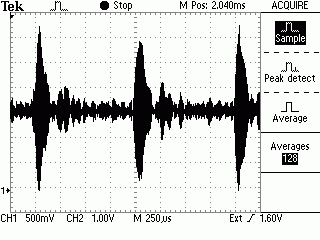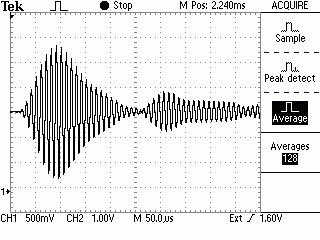Austron 2100F Loran-C Frequency Monitor
Loran-C by oscilloscope
For troubleshooting, education, or just plain entertainment the rear panel of
the Austron 2100F [1] has two BNC outputs that you can connect to an
oscilloscope [2].
The following is a scenic tour of what you can expect to see.
All transmissions are very short bursts of a couple dozen cycles of a 100 kHz
sine wave.
sine wave -> pulse -> group -> chain -> coverage
Transmitters from multiple sites
|
Austron 2100F Loran-C Frequency Monitor |
Every GRI, that is to say, every few tens of milliseconds a group of 8 or 9 pulses is
transmitted. The time from one pulse to the next within a group is 1
millisecond. The time from one group to the next group is the GRI (e.g., 99400
or 59900 microseconds for us near Seattle). Each pulse consists of about two
dozen cycles of 100 kHz of varying amplitude per cycle; the amplitude envelope
is special.
Scope Trigger
The following is a picture of the scope trigger output. In this
example the 2100F was tracking GRI 99400 -- that's 99400 us, or 99.4 ms -- so the
trigger has close to a 100 ms period and a 10 Hz rate.
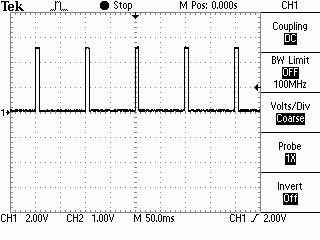
The width of the trigger pulse is 7.5 ms (slave) or 9.5 ms (master); just wide
enough to act as a gate for all the pulses that occur in each group.

Scope vertical
The scope vertical output is the live Loran-C RF signal with
one caveat: when the GRI gate is active the signal is raised about 1 volt.
This results in the pulses being raised on a pedestal and is done so that you
can see both the RF signal and the GRI gate in a single trace. More on that
later. The following picture shows the scope trigger signal on channel 1 and the
scope vertical signal on channel 2. Notice the RF signal has some noise but
shows 8 clear peaks within the gate (which are part of GRI 99400) and a few
peaks outside the gate (which must be part of another GRI).
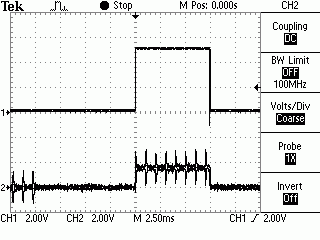
Zooming out a bit you can see multiple GRI. In this case the receiver was set
for GRI 99400 (the pulse groups are about 100 ms apart) but you can see another
equally strong group present in the RF signal. It is the GRI 59900 chain (the
pulse groups are about 60 ms apart). Since the pulses of different GRI often
come from different transmitters they can collide. The GRI numbers are chosen to
reduce the changes of collision. This picture covers 1/2 second of real time so
the rate of these pulses is relatively low compared with other signals in the RF
world.
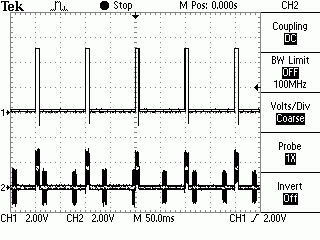
Now connecting the two signals as designed: scope trigger to external
trigger and scope vertical to channel 1 input (single channel mode) we
get a picture of the 8 pulses in the pulse group.
At 1 ms/div and centering we see the entire 8-pulse group. This means the
2100F has locked onto a slave site and not a master/
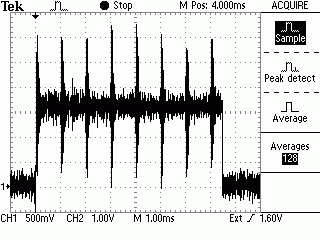
To get a clearer picture we switch to averaging mode. Note that the 2nd, 4th,
6th, and 8th pulse nearly vanish. This is due to phase reversals in successive
groups (improves noise rejection) and so you have to be careful with digital averaging 'scopes.
Note also a
slight echo of a pulse that immediately follows the main pulse. This sort of
noise is common.
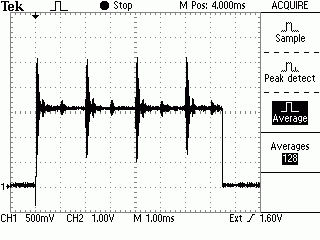
That's enough of looking at pulse groups. Increasing the sweep rate from 1
ms/div to 25 us/div gives us a look at a single pulse within the group. The
pulse is composed of a 100 kHz waveform whose amplitude follows a carefully
designed teardrop-looking envelope with a 200 to 250 us total duration. Because
the 2100F adds the gate to the RF signal there is a step at the third positive
zero crossing of the pulse. This shows you the exact spot in the waveform where
the 2100F is tracking.
The trigger occurs 10 us before the first pulse. The tracking point is 30 us
after that.
The RF waveform is smooth of course not jagged [3] as
seen here.
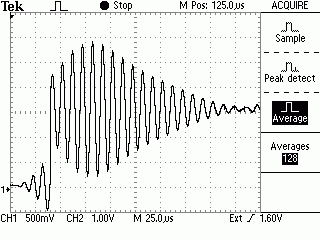
The odd numbered pulses of the group look like the first one. With a 4 ms
trigger delay the 5th pulse of the group is visible. Here's is the classic Loran
pulse envelope waveform.
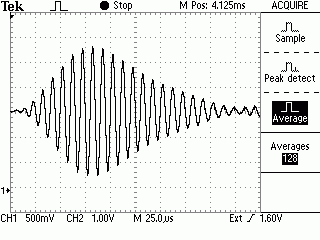
The even numbered pulses of the group alternate in phase. With a 1 ms trigger
delay we should see the 2nd pulse of the group but when the 'scope is in
averaging mode you see nothing.
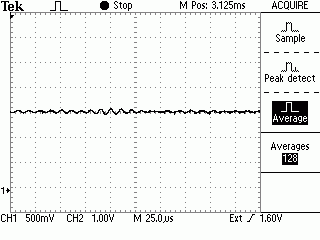
To get a view of the odd pulses we turn off averaging and add persistence.
The first picture is a view of an even pulse (2 ms trigger delay, third pulse of
8). The second picture is a view of an odd pulse (1 ms trigger delay, second
pulse of 8).
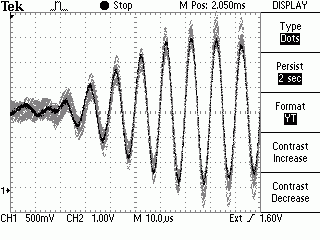
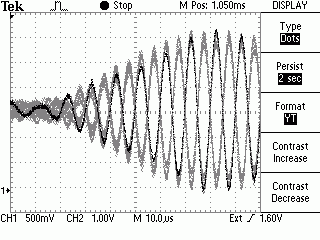
Finally, let's take a close in look at the third zero-crossing; the tracking
point.
The GRI trigger occurs 1 cycle (10 us) before the pulse starts. The tracking
point is the rising edge of the third cycle (30 us) after the pulse starts.
Therefore the tracking point is 40 us after the GRI trigger. So in most of the
frames to follow the trigger is 40 us left of center.
The manual says the rising edge of the trigger output is 40 us before the
rising edge of the third zero crossing. Sure enough, that's what we see.
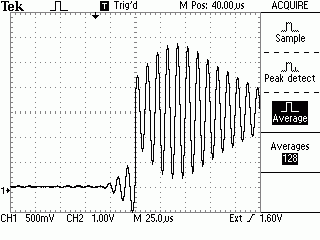
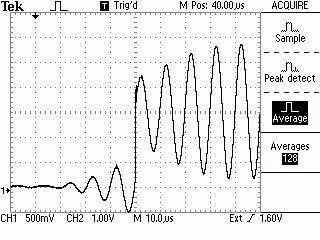
Finally, the Austron Loran-C manuals show how to check for the third
zero-crossing. Here's a picture of one of the even pulses with lines drawn
following the slope of the envelope. This technique can be used to verify which
zero crossing is the third.
To check the tracking point make a hardcopy of a nice looking Loran pulse. I
don't use the first pulse (because the pedestal distorts the shape) and I don't
use the second pulse (the shape averages to zero) so in this example I used the
third pulse, an offset of 2 ms from the trigger.
Sure enough, the RF is flat for the first two divisions then there are three
nice zero crossings.
For timing purposes note the USNO tick is synchronized to the first edge (the
receiver tracks the third edge) so the tick is 30 us before the tracking point;
10 us after the GRI trigger. Got that?
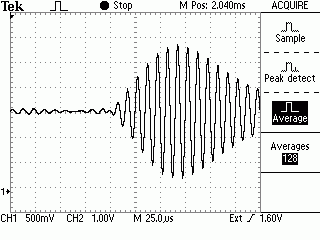
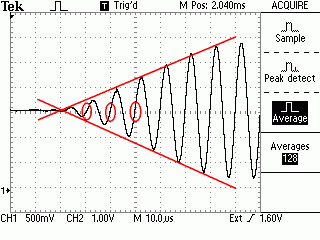
Center scale is 40 us from the start of the pulse (left). If you follow the
slope of the leading edge of the pulse and follow it back you can see the pulse
starts 25 us.
Ah, this just happened -- a set of strong echo pulses. You'll find if you
watch the Loran-C signal for a while that the patterns change considerably. It reminds me
of watching the dynamic patterns of the northern lights.
Footnotes
- I used an Austron 2100F Loran-C receiver in this
experiment although a plain Austron 2100 (the timing version) or Austron
2100R (the button-less reference version) would work equally well.
- Any old single trace
oscilloscope with 1 MHz bandwidth and external trigger input should work. I used a Tektronix TDS 220 digital
oscilloscope with the RS232 communication module and some homebrew software
to create the screen shots.
- The ragged appearance of the traces is due to the
limited resolution of the TDS scope. It has a resolution of 25 pixels per
division and an 8-bit DAC. The full screen size is 320x240; the 10x8
divisions cover a total of 250x200 pixels.
Send comments or questions: tvb
Return to Museum of Aging Oscillators
Return to LeapSecond.com home page















